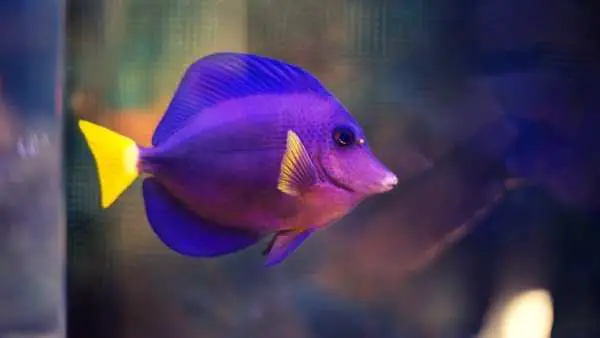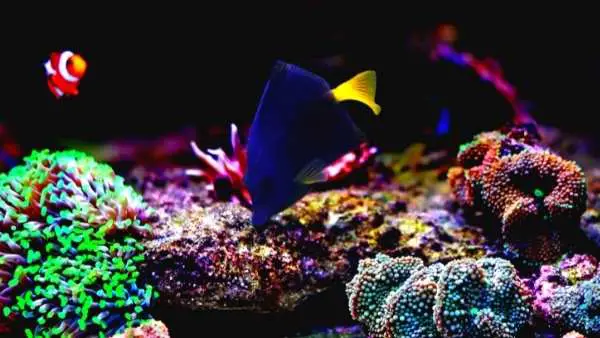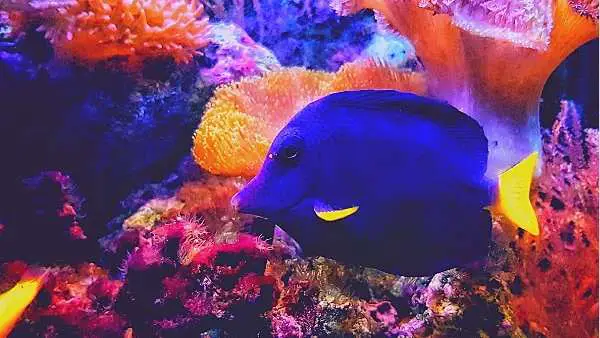Most hobbyists enjoy the process of building and adding to their aquariums for a multitude different, and valid, reasons, with perhaps one of the most popular being aesthetic purposes. When it comes to having your own tank, and building a community of fish, having attractive, brightly colored fish is simply a must.
Fish do not get much more unique and special in terms of awesome patterns and bright contrasting colors than the Purple Tang, which is also known as the Yellowtail Tang, Yellow-tail Sailfin Tang, Yellow-tail Surgeonfish, Blue Surgeonfish, or even Zebrasoma xanthurum.
Part of the ever-growing Tang fish species, which consists of 38 different types, the Purple Tang is a vibrant, purple bodied fish with a bright yellow tail, and yellow accents on the pectoral fins, and dark freckles on its face, which lead down the body to form somewhat of a light stripe formation.

The Purple Tang was first discovered by a zoologist by the name of Edward Blyth in 1852, this species of reef fish calls the Red Sea, Arabian Sea, Gulf of Aden, and waters off Sri Lanka its home. They thrive in coral-rich environments and can grow to a remarkable 10 inches (15 cm) in length. Usually living in solitary, the Purple Tang has been known to be occasionally found in schools, specifically in the Red Sea.
Purple Tang Appearance
These fish are some of the most beautiful saltwater fish out there, displaying such glorious colors and a fantastically unique, and at the same time, majestic body shape.
A slight problem, if you will, is their temperament, they are known to be more of the aggressive hailing from the Tang species, and so are highly recommended to be housed alone, and certainly without other fish of a similar shape, size, and aggressiveness. However, on the contrary, there have been some hobbyists that have not had any problems with adding multiples of the same species to their community at once.
When handling these beauties, do so with care, they are covered in sharp spines that run across both sides of their caudal fin, this is used as a defense mechanism when their territory is being invaded. Most Tangs have much smaller dorsal and anal fins than the Purple Tangs, which is why they have taken on a more disc-shaped appearance. When the fin reaches full extension, the height of the fish is similar enough in size to the length!
The Purple Tang will grow to a pretty reasonable size, 10 inches (25 cm) more, or less in a time between 3-5 years. Therefore, it is vital for them to be kept in an aquarium suitable for their size, they will use your tank thoroughly and occupy every part of it. They enjoy open swimming a lot of the time, but also enjoy some solace, so you will want to provide them with many holes and other hiding spots.

Tank Requirements and Additional Purple Tang Information
The minimum tank size required for the Purple Tang is 125 Gallons, which converts to 475 liters.
Unfortunately, as a hobbyist or an aspiring hobbyist and community owner you will own fish that are prone to diseases, which can cause additional work to make sure they remain healthy, but you can also see a premature death occur to one of your favorite little friends.
The Purple Tang is prone to several diseases such as Ich (Ick) & HLLE (Head & Lateral Line Erosion). These kinds of diseases tend to occur if the tank isn’t being regularly cleaned, and if the fish is mismanaged and not fed correctly.
Many people consider the purple tang as being a beginner compatible fish, however, we wouldn’t necessarily advise this beautiful Tang for first-time hobbyists. There is a lot to consider, research, and execute when it comes to keeping a happy and healthy Purple Tang, and you might just be better of gaining some valuable experience before jumping into the deep end of tank and community ownership.
These fish are extremely reef compatible and thrive within a reef environment. Also, once the Purple Tang reaches a larger size, they can be introduced to a predator tank. For the most part, they won’t be bothered by any predatorial fish.
The tanks pH level must range between 8.1 to 8.4, and, as mentioned previously, many hiding spaces are required for the morale of the fish, such as caves, rocks, and aquarium plants.
Purple Tangs also need to be kept predominantly on their own, unlike many other Tang species, they predominantly thrive by themselves. Sure, there are instances where they are fine with many other fish of the same species, but this is a bit of an anomaly, and you are better off keeping them alone from other Tangs as a rule of thumb. For invertebrates and smaller fish that will be potentially part of the community, Purple Tangs are peaceful around them and will cause no damage or harm to them.
Feeding Habits
Another factor in us recommending the Purple Tang for the more experienced hobbyists is their feeding habits. It is safe to say they are fussy eaters! They will spend their day pecking at the sand bed and rocks.
However, they will accept a mix of frozen and live algae-based foods. To avoid infectious diseases such as HLLE, which is an erosion disease, they must be fed a diet consisting of vegetables mainly. You will want to give your Purple Tangs the best fish food possible.
The Tangs are notoriously quick eaters, and it is important to make sure you are feeding enough for the other members of your community. They will graze on algae, seaweed, diatoms, filamentous algae, and detritus throughout the day, in between feeding times.

Acclimatization
In terms of acclimatization, you will need to place the fish in a bucket and then drip acclimate for 1 hour (60 minutes) at a rate of 3 drips per second, which will then bring the Purple Tangs water parameters in line with your tank.
After the Purple Tang has been acclimated, gather the fish with a net and place it gently into your tank, it is important to not mix any of the water the fish came in with into your own tank water! The lid to your tank must be on tightly and securely, Purple Tangs have been known to jump, especially when initially introduced to a brand-new environment.
Compatibility
A popular question regarding the Purple Tang is “can they be kept with other Tangs?”, unfortunately, these fish are some of the most aggressive in the Surgeonfish (Tang) family, meaning that it is strongly advised to keep them away from other Tang species.
However, they are considered, for the most part, to be compatible with most other living beings found in reef aquariums, but if they are substantially larger than their fellow tank mates, they can become tank bullies.
Conclusion
Despite the recommendations, if you are brave enough to have the Purple Tang mixed with other Tangs, the Purple Tang should certainly be the last Tang to be added to the aquarium, this will allow the other fish to settle and establish a territory. As well, they tend to do well with other Tangs that are not similar in shape and size, but as long as you have an established tank that is big enough, you can potentially accommodate different types of Tanks to live with the Purple Tang.
